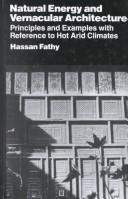Check nearby libraries
Buy this book

The field of vernacular architecture offers an abundance of concepts that can be of use today in solving the critical housing situation now facing millions in the Third World. The example chosen to illustrate this by the UNU Energy Subprogramme covers the vernacular architecture of the hot, arid zones of the Arab World and neighboring regions. It was felt that the person best suited to prepare a monograph on this subject was Professor Hassan Fathy. Not only is Professor Fathy a master architect and an expert in the area of traditional architecture, especially in the Arab World, but he has been so for more than half a century. His work has also demonstrated the value that traditional architecture can have in improving the housing and living environments of the poor of the Third World. As a theoretician and practitioner of environmental planning design, Dr. Fathy's approach is based on a set of principles that are useful in opening the mind to the value of vernacular architecture and to adapting it to the situation in which a large fraction of the world's population find themselves today. Professor Fathy's approach is based on the concept that architectural form should be determined by spiritual, artistic, climatic, and social considerations as well as function, material, and structure. He emphasizes that due consideration must be given to a number of elements including harmony. -- from Foreword.
Check nearby libraries
Buy this book

| Edition | Availability |
|---|---|
|
1
Natural energy and vernacular architecture: principles and examples with reference to hot arid climates
1986, Published for the United Nations University by the University of Chicago Press
in English
0226239179 9780226239170
|
aaaa
Libraries near you:
WorldCat
|
Book Details
First Sentence
"Hundreds of millions of people in the world today live in poor housing under adverse climatic conditions that stress their undernourished bodies toward the limits of human endurance and occasionally beyond. The poverty of these people severely restrains their ability to procure the energy required to provide healthful climatic conditions within their homes. Yet their ancestors survived, and often lived comfortably, for centuries under the same climatic conditions in dwellings of traditional design. They were able to do so because they made use of the energy available locally in the environment. Many traditional societies in climates with cold seasons relied on firewood and organic waste to provide them with the heat they needed. People living in the hot, arid climates, however, were faced with a different problem: high daytime and cool nighttime temperatures with very little humidity. More than firewood is needed to solve climatic problems of this type. The solutions that were found relied on energy from the sun and wind and the innovative, architectural structures and forms that were developed to make use of this natural energy. The vernacular architecture of the Arab World and neighboring regions not only solved the climatic problems but did so with a combination of beauty and physical and social functionality. This book describes some elements of the vernacular architecture developed by these societies over many generations to provide a comfortable microclimate using natural energy."
Edition Notes
Bibliography: p. 167-169.
Includes index.
Classifications
The Physical Object
ID Numbers
Community Reviews (0)
Feedback?History
- Created April 1, 2008
- 15 revisions
Wikipedia citation
×CloseCopy and paste this code into your Wikipedia page. Need help?
| July 20, 2024 | Edited by MARC Bot | import existing book |
| December 11, 2023 | Edited by MARC Bot | import existing book |
| June 18, 2022 | Edited by ImportBot | import existing book |
| June 17, 2022 | Edited by ImportBot | import existing book |
| April 1, 2008 | Created by an anonymous user | Imported from Scriblio MARC record |









